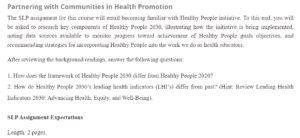Partnering with Communities in Health Promotion
With conditions such as diabetes, cancer, blood pressure, obesity, and heart disease becoming increasingly prevalent and deadly in the United States, the government, scientists, and other stakeholders are now looking at alternative preventive methods not to replace but to support the traditional therapy-centered approaches. One particular approach researchers are looking into includes the use of community partnerships to promote health. According to Bajracharya, Bell, & Bowler (2004), community alliances and partnerships are part of the broader concept of addressing key risks to health as well as sustainable growth. Some of these collaborative efforts are associated with the elimination of management and an increase in disease control, access to knowledge and information, research and development, as well as advocacy and promotion of health. One of the noticeable efforts the U.S. government has implemented in recent years is the introduction of the Healthy People initiative – a countrywide program aimed at fostering disease-prevention and health-promotion targets set by the HHS (U.S. Department of Health and Human Services). This program started in 2000 and set forth specific goals to be achieved within the next ten years (until 2010). Besides the 2010 program, the HHS has rolled out two different Healthy People programs, including Healthy People 2020 and now Healthy People 2030. This paper will specifically discuss how the 2030 framework differs from the 2020 model and the difference in health indicators between the two models.
The Difference Between the 2030 Healthy People Framework and the 2020 Version
‘Healthy People’ 2030 is the 5th iteration of the Healthy People program since its introduction in 1979. It was released on August 18, 2020, and includes a broad range of elements from overarching goals, foundational principles, mission, vision, core targets, and objectives to research and development. Similar to the previous versions, including the 2020 iteration, the Healthy People 2030 plan was designed via a multilayer process that factors the public’s contribution, the Secretary’s Committee, input from private and public organizations, as well as recommendations from an independent advisory committee.
However, certain modifications and additions have been made in the 2030 version, which were absent in the 2020 model. For instance, the 2030 edition lays out more statistically thorough, evidence-based, and focused objectives. More so, several new data-related protocols were used during the selection of data sources and objectives. For instance, the data used is valid, reliable, and reflects the countrywide picture with no primary methodological problems, such as low or unknown response rates, inadequate sample size, limited population coverage, etc. The data is also timely; no baseline data older than 2015 was applied. A measure of variability has also been introduced, plus a guarantee of two extra data points within the next ten years. Data has also been made publicly available with full documentation, with national government oversight or management. The 2030 iteration also has three classes of objectives: core objectives, research objectives, and developmental objectives (CDC, 2020).
The Difference Between Healthy People 2030’s Leading Health Indicators from the Previous Variants
Leading health indicators (LHIs) are defined as a selection of superior or high-priority objectives identified to steer action aimed at enhancing well-being and health. The difference between the 2020 and 2030 versions of Healthy People is the reduction in the number of LHIs from 26 to 23, respectively. The 2020 version laid focus on 12 key areas, including access to health services, environmental quality, clinical preventive services, injury and violence, mental health, maternal infant and child health, oral health, substance abuse, social determinants, reproductive and sexual health, tobacco, and nutrition, physical activity, and obesity. Some of these key themes were added, while some were modified from the 2020 version.
References
Bajracharya, S., Bell, C., & Bowler, S. (2004). Partnership for a Healthy Community: A Tobacco Prevention Program in Central Aroostook County. American Journal of Health Education, 35(5), 305-308. Retrieved May 1, 2012, from ProQuest.
CDC. (2020). Healthy People 2030. Retrieved from https://www.cdc.gov/nchs/about/factsheets/factsheet-hp2030.htm
U.S. Department of Health and Human Services. (2010). Healthy People 2020: Leading Health Indicators. Retrieved May 1, 2012, from http://www.healthypeople.gov/2020/LHI/default.aspx
ORDER A PLAGIARISM-FREE PAPER HERE
We’ll write everything from scratch
Question 
Partnering with Communities in Health Promotion
The SLP assignment for this course will entail becoming familiar with Healthy People initiative. To this end, you will be asked to research key components of Healthy People 2030, illustrating how the initiative is being implemented, noting data sources available to monitor progress toward achievement of Healthy People goals objectives, and recommending strategies for incorporating Healthy People into the work we do as health educators.

Partnering with Communities in Health Promotion
After reviewing the background readings, answer the following questions:
- How does the framework of Healthy People 2030 differ from Healthy People 2020?
- How do Healthy People 2030’s leading health indicators (LHI’s) differ from past? (Hint: Review Leading Health Indicators 2030: Advancing Health, Equity, and Well-Being).
SLP Assignment Expectations
Length: 2 pages.
- Bajracharya, S., Bell, C., & Bowler, S. (2004). Partnership for a Healthy Community: A Tobacco Prevention Program in Central Aroostook County. American Journal of Health Education, 35(5), 305-308. Retrieved May 1, 2012, from ProQuest.
- National Commission for Health Education Credentialing, Inc. (2011). Responsibilities & Competencies. Retrieved May 1, 2012, from http://www.nchec.org/
credentialing/ responsibilities/ - U.S. Department of Health and Human Services. (2010). Healthy People 2020: Leading Health Indicators. Retrieved May 1, 2012, from http://www.healthypeople.
gov/2020/LHI/default.aspx
